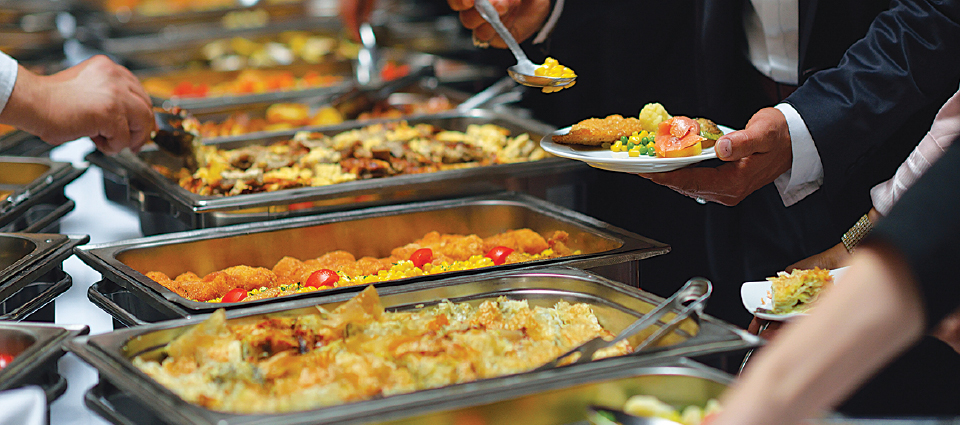Grocery Stores, Make Meals Easy (Here’s Why)
February 05, 2018In honor of National Pride in Food Service Week, we would like to thank food service workers, especially those in grocery stores, for their hard work and dedication to the job.
Foodservice at the grocery store is such a trending topic that the Food Marketing Institute recently released a report about foodservice trends. It’s an important topic to consider in light of the fact that grocery ecommerce is expected to take 10% of the total grocery market by 2020, which is a 7.6% increase from its market share in 2015.
Foodservice at the grocery store is a way to keep the brick and mortar store relevant in the growing age of grocery ecommerce. This article shows that foodservice is an expanding opportunity for grocery stores, dissects consumer preferences for quick and easy meals and examines consumer spending on grocery-prepared foods.
Going Grocerant
Foodservice at the grocery store comes in three varieties: meals that the store prepares and serves (such as fried chicken, salad and soup bars); pre-made grab-and-go items (sandwiches, salads, etc.); and take-and-bake dishes (like casseroles). Grocery stores that provide meals are called “grocerants,” which mashes up the words “grocery” and “restaurant.”
No matter which term you prefer, there’s no question that it represents significant sales potential. Fresh and perishable food in-store sales grew by $1.5 Billion from 2016 to 2017 and there was a 20% increase in food and beverage ecommerce in the US from 2016 to 2017.
Over 40 percent of the U.S. population purchases prepared foods from grocery store. Revenue for prepared food service at supermarkets grew an average of 10% per year from 2005 to 2015. The grocery prepared food market is now at about an estimated $29 billion.
Managing Meals
Consumers are looking for meal options outside the home. Findings from the Food Marketing Institute’s foodservice latest report show how consumers approach quick and easy meals.
• 63% of consumers use technology to help them decide where and what to eat for dinner.
• The average customer purchases grocery deli-prepared items 3 times per week.
• 55% of consumers combine convenience items with cooking from scratch.
• 8% of shoppers rely on semi or fully prepared items for their meals.
• When shoppers aren’t in the mood to cook, 69% go to a restaurant and 31% buy prepared grocery deli.
• 68% of shoppers say grocery isn’t on their radar when considering fast meal solutions.
This shows the necessity for an awareness advertising campaign! Most consumers prefer to learn about deli promotions via email and text.
• 32% of shoppers say their grocery stores don’t necessarily meet their culinary expectations.
• 50 percent of shoppers purchase grocery deli prepared beyond their primary store, and 50 percent say it is typically a substitute for home-cooked items.
The consumer group that shows the highest preference for convenient meals is Millennials, according to the Food Purchase Decisions of Millennial Households report from the US Department of Agriculture. Millennials spend less time preparing food, make fewer grocery store trips and spend the least amount of money on groceries than any other age group.
Percent of individuals who bought prepared food from a grocery store deli, food delivery service or fast food within the last 7 days by generation:
• 62% Millennials
• 56% Gen X
• 59% Baby Boomers
• 47% Silent Generation
Average amount of time spent in food preparation, presentation and cleanup:
• 88 minutes Millennials
• 55 fewer minutes than Gen X
• 48 minutes fewer than Baby Boomers
• 143 minutes Gen X
• At almost 2 ½ hours, this is the highest!
• 136 minutes Baby Boomers
• 101 minutes Silent Generation
Purchasing Preferences
Do shoppers prefer hot or cold meals? Which grocery-prepared food items show the highest amount of growth? Read on to find out.
Consumers purchase these fresh-prepared foods:
• hot ready to eat meals from deli/prepared food area
• 53% younger Millennials
• 74% older Millennials
• 65% Gen X
• 71% Baby Boomers
• 65% Silent Generation
• cold ready-to-eat foods from deli/prepared food area
• 62% younger Millennials
• 71% older Millennials
• 64% Gen X
• 48% Baby Boomers
• 60% Silent Generation
• heat and eat chilled foods from deli/prepared food area
• 44% younger Millennials
• 56% older Millennials
• 40% Gen X
• 34% Baby Boomers
• 25% Silent Generation
• meals/beverages from in-store restaurant
• 36% younger Millennials
• 44% older Millennials
• 22% Gen X
• 18% Baby Boomers
• 13% Silent Generation
These foodservice items saw this much growth from September 2016 to 2017:
• 15% sushi
• 8% packaged meals with meat
• 7% value-added vegetables
• 6% packaged salad
Consumers are looking for ethically sourced and organic ingredients, protein-packed meals and plant-based meals, according to the “Growing Grocerants” article in the January 2018 Progressive Grocer magazine. The following prepared food items saw this much growth in the past year:
• 446% breakfast sandwiches
• 42% snack sandwich wraps
• 18% breakfast wraps
• 26% lettuce/green salads
• 16% pasta salads
• 10% potato salads
• 56% quiche (refrigerated section grab-and-go)
• 23% casseroles/baked dishes (refrigerated section grab-and-go)
• 13% pasta (refrigerated section grab-and-go)
• 12% stuffed grape leaves (refrigerated section grab-and-go)
Food items with these health and wellness claims saw this much growth from September 2016 to 2017:
• 46% grain free, or $706 Million
• 32% cruelty free, or $846 Million
• 29% Grass fed, or $638 Million
• 22% corn free, or $1.36 Billion
• 21% Stevia, or $2.18 Billion

